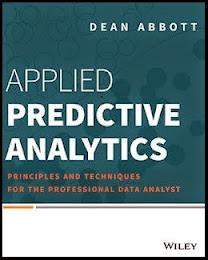The website http://videolectures.net/ contains a wealth of interesting lectures on a wide variety of topics, including data mining. I was reminded of one today by
Ronny Kohavi entitled "
Practical Guide to Controlled Experiments on the Web: Listen to Your Customers not to the HiPPO" It's short (only 23 minutes) and filled with some very good common-sense principles.
First, it is a talk about the importance of A/B testing, or in other words, constructing experiments to learn customer behavior rather than having the experts make a best guess at how people will behave. He gives some good examples from Microsoft and the sometimes non-intuitive results from actual testing. A book he recommends is
Breakthrough Business Results With MVT: A Fast, Cost-Free, Secret Weapon for Boosting Sales, Cutting Expenses, and Improving Any Business Process
The second part of the lecture I found particularly interesting is what Kohavi calls the Overall Evaluation Criterion (OEC), or what I usually call business objectives. He included the great Lewis Carroll quote, "If you don't know where you are going, any road will take you there." I find this a common problem as well: if we don't define a business objective that truly measures the impact of the predictive models we build, we have no way of determining if they are effective or not. This objective must be tied to the business itself. For example, Kohavi argues for using Customer Lifetime Value (CLV) rather than click-through rates as they are more tied to the bottom line.
I would add that it can be useful to have two objectives that are measurable, especially if two objectives better measure the value. For example, in collections risk models, the age of the debt and the amount of the debt are both important components to risk. These are difficult to put into a single number in general, so the two-dimensional risk score can be helpful operationally.






1 comment:
The measurement of customer lifetime value is a very good point. I have an example from the telco market. To measure the CLV you not only need to consider the turnover generated by each subscriber but also the churn with respect to tariff and channel of distribution.
Post a Comment